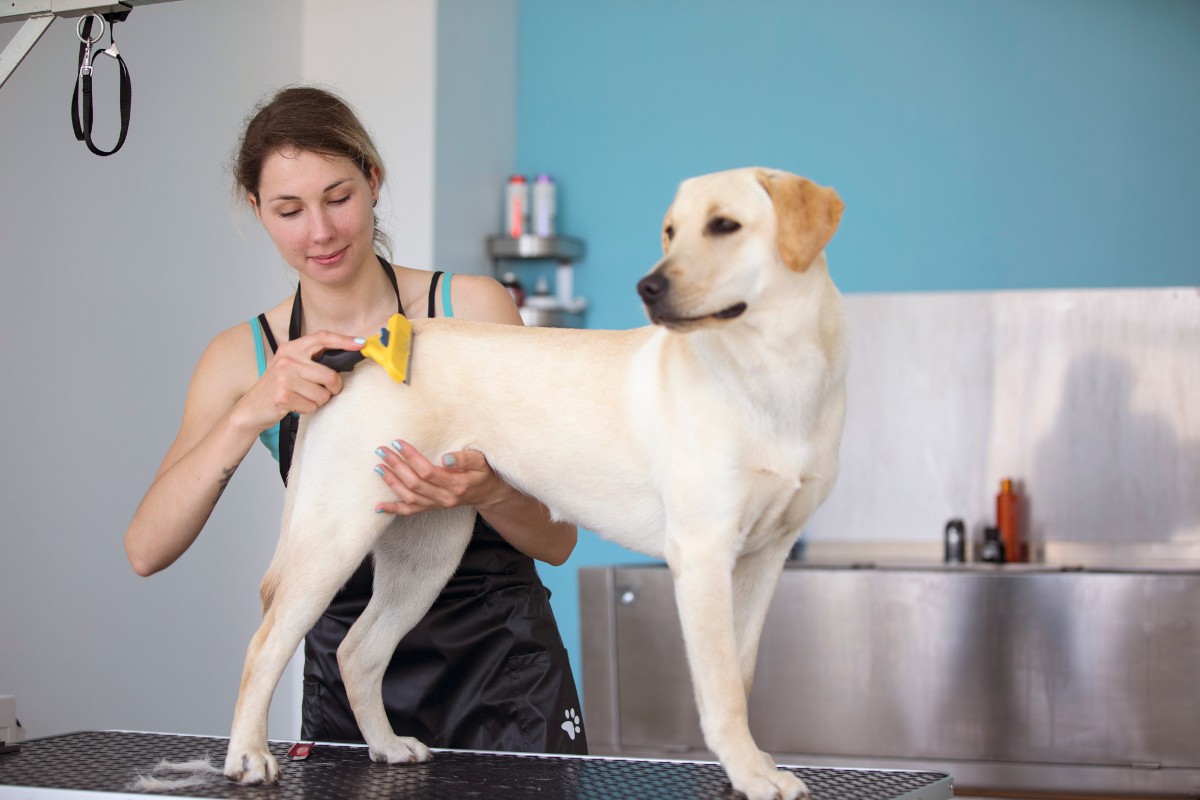This actionable guide will walk you through the essential steps to starting a pet sitting business.
It’s not just about earning a living; it’s about turning your passion into a profession that enriches your life and the lives of the pets you care for.
Post Contents
- 1 How to Start a Pet Sitting Business
- 2 Frequently Asked Questions
- 3 Conclusion
How to Start a Pet Sitting Business
1. Understanding the Pet Sitting Industry

Before you dive into the world of pet sitting, it’s crucial to understand the industry thoroughly.
The pet-sitting business provides professional care for pets when their owners are unavailable.
With pet ownership on the rise, the demand for pet sitters is steadily increasing.
The modern industry has evolved to encompass a wide range of services.
Pet sitters don’t merely feed and walk pets; they offer companionship, administer medications, and provide a safe and comfortable environment.
Understanding the diverse needs of pet owners and the varied services you can offer will set you on the right path.
To excel in this field, you must be dedicated, compassionate, and knowledgeable about various animals.
Different breeds, species, and individual personalities all require unique care.
Being well-versed in the behaviors, dietary needs, and health considerations of different pets will help you build a strong reputation and gain the trust of your clients.
2. Legal Requirements and Insurance
Like any business, your pet sitting service should adhere to local regulations and licensing requirements.
Check with your local government and animal control authorities to determine what permits or licenses are necessary to operate your business legally.
While regulations can vary from one location to another, standard requirements often include business licenses, health and safety standards, and insurance coverage.
You might also want to consider obtaining insurance to protect yourself and your clients in case of unforeseen events.
Pet accidents, injuries, or emergencies can happen, and having appropriate insurance coverage will help mitigate potential liabilities and demonstrate your commitment to professionalism and responsibility.
3. Creating a Business Plan
A well-thought-out business plan is a roadmap for success.
It should include your business goals, target audience, pricing strategy, marketing plan, and financial projections.
Your business goals should be specific and measurable.
Whether you aim to serve a certain number of clients within a particular timeframe or expand your services to include pet grooming or training, clear objectives will help you stay focused and motivated.
Identifying your target audience is crucial for tailoring your services and marketing efforts.
Are you catering to busy working professionals, vacationing families, or elderly pet owners?
Knowing your audience will guide your marketing strategies and help you connect with potential clients.
Your pricing strategy should be competitive and reflective of the quality of service you provide.
Consider researching your local market and competitors to set competitive rates.
You may also want to offer different pricing packages for various client needs and budgets.
A comprehensive business plan will help you stay on track and make informed decisions as your pet sitting business grows.
Regularly revisiting and updating your plan can ensure your business remains flexible and adaptive to changing market conditions.
4. Market Your Business

Promoting your pet-sitting business is essential to connect with pet owners in your area and grow your clientele.
Here are some effective strategies to consider:
Design Eye-Catching Promotional Materials
Craft visually appealing flyers and professional business cards.
Place flyers in popular dog parks and pet stores and give business cards to potential clients.
You can create these materials or opt for a polished, custom design.
Establish Local Business Relationships
Forge strong connections with local veterinarians, pet stores, and other businesses in the pet care industry.
These establishments often serve as valuable referral sources.
Collaborating with pet food stores, pet grooming services, and licensed veterinarians can lead to new clients seeking your services.
Utilize Online Directories and Reviews
Make the most of online platforms widely used by pet owners.
List your pet-sitting business on local directories like Google Maps, review sites such as Yelp, and industry-specific directories like Pet Sitters International.
Positive reviews and online visibility can boost your credibility.
Incentivize New Clients with Promotions
Attracting new clients can be achieved by offering promotions and discounts.
Depending on your budget and business expenses, consider providing introductory discounts or buy-one-get-one-free deals.
These incentives can encourage pet owners to give your services a try, paving the way for long-term engagements at your standard rates.
5. Offer Specialised Services
One way to stand out in the competitive pet sitting industry is by offering specialized services.
Consider focusing on a niche, such as caring for specific breeds, exotic animals, or pets with special needs.
You could offer specialized services for exotic pets, such as reptiles, birds, or small mammals.
Consider offering training and behavior modification services in addition to pet sitting.
This can help pet owners address behavioral issues and improve their pet’s obedience.
Specialize in administering medications, injections, or other medical care for pets with chronic conditions.
You can also provide pet grooming and spa services, including baths, haircuts, and nail trims.
Meeting the distinct needs of these pets can set you apart from the competition and attract a unique clientele.
6. Pricing Your Services
Determining the proper pricing for your pet sitting services can be challenging but is essential for the success of your business.
Research your local market and competitors to set competitive rates.
A pricing strategy that is attractive to pet owners and reflects the quality of service you provide will set you apart.
Consider offering different packages to cater to various client needs and budgets.
Some pet owners may require daily walks, while others need extended in-home care.
Providing flexible options can attract a diverse clientele and ensure you’re meeting the unique needs of each pet and owner.
7. Providing Exceptional Service

The heart of your pet sitting business is the quality of care you provide to your furry clients.
Always prioritize the well-being, comfort, and happiness of the animals under your care.
Create a comfortable and safe environment for the pets you look after.
Offer stimulating activities and companionship to keep them happy and healthy.
Take time to understand each pet’s needs and preferences, whether it’s a favorite toy, treat, or a unique spot to be scratched.
Building solid relationships with the animals under your care is vital to their happiness and your success.
Remember that pets are family members to their owners, and they entrust you with their well-being.
Ensure you maintain open communication with pet owners, sharing updates and photos during their absence to give them peace of mind.
8. Expanding Your Business
As your pet sitting business grows, consider expanding your operations.
This growth can be achieved in several ways:
- Hiring Additional Staff: If you find yourself overwhelmed with clients, consider bringing in trained and passionate individuals to assist you in providing top-notch pet care.
- Expanding Your Service Area: If you have a thriving pet sitting business in your local community, consider expanding your service area. It can help you reach more pet owners and increase your revenue.
- Offering Additional Services: To diversify your revenue streams, consider adding complementary services like pet grooming, training, or pet transportation. These can be attractive add-ons for your clients and contribute to the growth of your business.
Frequently Asked Questions
How much should I charge for pet sitting services?
Your rates should reflect the local market while considering your costs and unique selling points.
Research and offer competitive prices.
Do I need any formal training or certifications to become a pet sitter?
While formal training and certifications are not mandatory, they can enhance your credibility and marketability.
Organizations like Pet Sitters International (PSI) offer courses and certifications that can boost your knowledge and skills in pet care.
Are there any specific tax considerations for pet sitters running their businesses?
Yes, running a pet sitting business comes with tax responsibilities.
You’ll need to keep detailed financial records, report your income, and potentially pay self-employment taxes.
Consulting with a tax professional or accountant can help you navigate the tax implications of your business.
Conclusion
Success isn’t just about profit and numbers from the start; it’s about making a meaningful impact.
As you’ve discovered in this guide, learning how to start a pet sitting business is not only about financial gain but also about nurturing the well-being and happiness of our beloved pets.
The satisfaction of providing love and care to animals and the gratitude of pet owners are the true rewards of this endeavor.
So, take the knowledge you’ve gained here and step into a world where your passion can thrive as a fulfilling and trusted pet sitter.






























